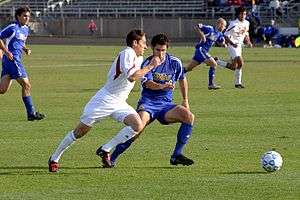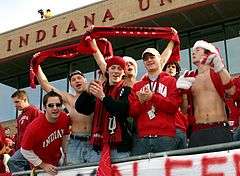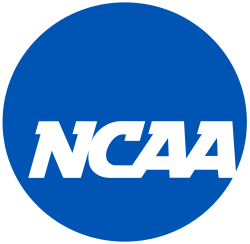College soccer
College soccer is played by teams of soccer students throughout colleges and universities. It is most widespread in the United States, but is also prominent in South Korea and Canada. The institutions typically hire full-time professional coaches and staff, although the student athletes are strictly amateur and are not paid. College soccer in the United States is sponsored by the National Collegiate Athletic Association (NCAA), the sports regulatory body for major universities, and by the governing bodies for smaller universities and colleges.
College soccer teams play a variety of conference and non-conference games throughout the fall season, with the season culminating in the post-season tournament called the College Cup. The St. Louis University Billikens are the most successful team, having won 10 College Cups.
Top college players often go on to play professionally in Major League Soccer or other professional leagues. The best college soccer player each year is awarded the Hermann Trophy.

Competition format
College soccer is played in the fall. The regular season lasts from late August to early November, playing games against both conference opponents and non-conference opponents. The NCAA championship is played in November and December, with 48 teams qualifying for the playoffs.
Proposed Division I season change
After many months of extended unofficial discussion, on August 22, 2016, NCAA Division I men's coaches and the National Soccer Coaches Association of America (NSCAA) officially began an "informational campaign" to build support for a proposed change of the playing schedule for Division I men's soccer. Under the proposed changes of the "Academic Year Season Model", the number of games on the Fall schedule and the number of mid-week games would be reduced, with games added in the Spring following a Winter break, and the NCAA Division I Men's Soccer Championship tournament would be moved from November and December to May and June. In addition to more closely matching the professional season, the changes address issues of player health and safety and of the time demands on student-athletes. The proposal concerns only Division I men's soccer. While a large majority of men's coaches and players support the changes, only a small minority of women's coaches and players currently do so. At this time, there is only the "informational campaign" "...to educate our Athletic Directors, NCAA leadership, student athletes, coaches and fans on the advantages of this Academic Year Model," said Sasho Cirovski, NSCAA D1 Men's committee chair and University of Maryland head coach. No formal proposal has been made to the NCAA.[1][2]
Rules
While similar in general appearance, NCAA rules diverge significantly from FIFA Laws of the Game. If a player accumulates five yellow cards over the course of one season, they are banned for one game. A manager may make limited substitutions, and each player is allowed one re-entry which must occur in the second half of the match unless the substitution was caused by a player injury resulting from a caution or send-off. All matches have an overtime period if the game remains tied after 90 minutes. As opposed to a regular two-half extra time period, a sudden death scoring rule is applied. If neither team scores in the two ten-minute halves, the match ends in a draw (unless it is a playoff match, then it would go to a penalty shootout). College soccer is played with a clock that can be stopped when signaled to by the referee for injuries, the issuing of misconducts, or when the referee feels a team is wasting time. The clock is also stopped after goals until play is restarted, and the clock generally counts down from 45:00 to 0:00 in each half. In most professional soccer leagues, there is an up-counting clock with the referee adding injury time to the end of each 45-minute half.[3]
Attendance leaders

The following Division I soccer teams had an average home game attendance of at least 2,000 during the 2015 season.[4]
| Rank | Program | Conference | Home games |
Average attendance |
|---|---|---|---|---|
| 1 | UC Santa Barbara Gauchos | Big West | 12 | 3,844 |
| 2 | UConn Huskies | American | 12 | 3,504 |
| 3 | Creighton Bluejays | Big East | 14 | 3,297 |
| 4 | Maryland Terrapins | Big Ten | 11 | 3,203 |
| 5 | Wake Forest Demon Deacons | ACC | 17 | 2,720 |
| 6 | Louisville Cardinals | ACC | 11 | 2,663 |
| 7 | Clemson Tigers | ACC | 15 | 2,648 |
| 8 | Cal Poly Mustangs | Big West | 9 | 2,488 |
| 9 | South Carolina Gamecocks | SEC | 10 | 2,245 |
| 10 | Akron Zips | MAC | 14 | 2,186 |
History of college soccer in the U.S.
The first de facto college football game held in the U.S. in 1869 between Rutgers University and Princeton was contested under the London Football Association rules at Rutgers captain John W. Leggett' request, with the game being played under Association (soccer) rules mixed with Rugby. However most sports historians argue that this was actually the first-ever college gridiron football season in history.
The NCAA first began holding a national championship in 1959, Prior to 1959, the national champion had been determined by a national poll instead of through a national tournament.
St. Louis University won the 1959 inaugural championship using mostly local players, defeating a number of teams that were mostly foreign players.[5] St. Louis University continued to dominate the Division I Championship for a number of years, appearing in five consecutive finals from 1959 to 1963 and winning four; and appearing in six consecutive finals from 1969 to 1974 and winning four. College soccer continued growing throughout the 1970s, with the NCAA adding a Division III in 1974 to accommodate the growing number of schools.[6]
Indiana University's men's soccer program achieved success in the 1980s, 1990s, and 2000s with 8 national championships, 6 Hermann Trophy winners (national player of the year), and 13 national team players. From 1973 to 2003 no team won more national championships or had more NCAA College Cup appearances than Indiana.
Virginia won a record four consecutive national championships from 1991 to 1994 under head coach Bruce Arena.
College Cup
The following teams have won the College Cup two or more times.
| Team | Number | Years won |
|---|---|---|
| St. Louis | 10 | 1959, 1960, 1962, 1963, 1965, 1967 †, 1969, 1970, 1972, 1973 |
| Indiana | 8 | 1982, 1983, 1988, 1998, 1999, 2003, 2004, 2012 |
| Virginia | 7 | 1989 †, 1991, 1992, 1993, 1994, 2009, 2014 |
| San Francisco | 4 | 1966, 1975, 1976, 1980 |
| UCLA | 4 | 1985, 1990, 1997, 2002 |
| Maryland | 3 | 1968 ‡, 2005, 2008 |
| Clemson | 2 | 1984, 1987 |
| Connecticut | 2 | 1981, 2000 |
| Michigan State | 2 | 1967 †, 1968 ‡ |
| North Carolina | 2 | 2001, 2011 |
Side Notes:
- † Co-champions—Game called due to weather
- ‡ Co-champions—Game was declared a draw
Players and coaches
One of the major parts in soccer are the coaches. This is because the coaches help the players improve and use their skills efficiently on the field. The coaches also evaluate the opposing team in order to help their own team to know where to focus on. The coaches also motivate their players by talking to them, being hard on them, and pushing them to their maximum ability. Coaches will also find themselves working as mentors. This is because coaches guide less experienced people by building trust and modelling positive behavior. On top of that, beginning the season the players usually begin at a certain skill level, but under the coaches guidance, their skill level should improve as the season progresses.
Furthermore, coaches should focus on improving the team as a whole, not just improving each individual player. At the beginning of the season, coaches set goals for the team and work towards achieving those goals as a group not as individuals. Coaches need to make the team understand that they will win and lose as a team, so they set goals for the entire team. Coaches also teach their players that they have to perform to their best all the time for the team and teach the players lessons that will serve them well throught their athletic careers.
A number of American college soccer programs have developed talent that has gone on to play professionally or for the U.S. national team. Every year since its inception in 1996, Major League Soccer holds a SuperDraft in which MLS teams draft young prospects. The draft picks in the MLS SuperDraft are often U.S. based college soccer players.
The Hermann Trophy is awarded annually by the Missouri Athletic Club to the top male and female college soccer players in the United States. At the start of the college soccer season a list of Hermann Trophy nominees is compiled. Near the end of the college regular season, 15 players are announced as semifinalists. In early December the top three vote-getters for both the men's and women's trophy are announced as finalists. In an annual banquet held at the Missouri Athletic Club of St. Louis, the winners of the two awards are announced. Hermann Trophy winners who have starred for the U.S. national team at multiple FIFA World Cups include Tony Meola (1989), Alexi Lalas (1991), and Claudio Reyna (1993).
Many top American college soccer players play for separate teams in the Premier Development League (PDL) during the summer. One college club, the BYU Cougars men's team, has foregone playing in the NCAA or NAIA and instead play all of their games in the PDL.[7]
Several coaches who have won the College Cup have gone on to coach Division I professional soccer or even the U.S. national team. The most well known NCAA coaches who have gone on to success in the professional ranks include Bruce Arena (four College Cups with Virginia from 1991 to 1994), and Sigi Schmid (won two College Cups with UCLA in 1985 and 1990).
Divisions and conferences in the United States
There are approximately 800 NCAA men's soccer programs—206 NCAA Division I, 207 Division II, and 408 Division III.[8] There are 959 NCAA women's soccer teams—310 Division I, 225 Division II, and 424 Division III.[9]
The number of men's Division I programs has stayed roughly constant since the mid-1990s, but the number of women's Division I programs has increased from 190 in 1995-96 to 310 in 2008-09.[10]
NCAA Division I
- American Athletic Conference
- America East Conference
- Atlantic Coast Conference
- Atlantic 10 Conference
- Atlantic Sun Conference
- Big East Conference
- Big South Conference
- Big Ten Conference
- Big West Conference
- Colonial Athletic Association
- Conference USA
- Horizon League
- Ivy League
- Metro Atlantic Athletic Conference
- Mid-American Conference
- Missouri Valley Conference
- Northeast Conference
- Ohio Valley Conference
- Pac-12 Conference
- Patriot League
- Southern Conference
- Southwestern Athletic Conference
- The Summit League
- Sun Belt Conference
- West Coast Conference
- Independents
NCAA Division II
- California Collegiate Athletic Association
- Central Atlantic Collegiate Conference
- Conference Carolinas
- East Coast Conference
- Great Lakes Intercollegiate Athletic Conference
- Great Lakes Valley Conference
- Great Midwest Athletic Conference
- Great Northwest Athletic Conference
- Gulf South Conference
- Heartland Conference
- Mid–America Intercollegiate Athletics Association
- Mountain East Conference
- Northeast Ten Conference
- Northern Sun Intercollegiate Conference
- Pacific West Conference
- Peach Belt Conference
- Pennsylvania State Athletic Conference
- Rocky Mountain Athletic Conference
- South Atlantic Conference
- Sunshine State Conference
- NCAA Division II independent schools
- Lone Star Conference
Divisions and conferences internationally
In the United Kingdom, the BUSA Football League governs association football in colleges and universities.[11]
In South Korea, the university football competition is called the U-League.[12] Created in 2008, it is the first organized league competition for university football teams and operates outside of the regular Korean football league structure.
Canada
In Canada, there are two organizations that regulate university and collegiate athletics:
Canadian Interuniversity Sport (CIS) |
Canadian Colleges Athletic Association |
National college soccer awards
- See Category:College soccer trophies and awards in the United States
- Soccer America Player of the Year
- ISAA Player of the Year
- ISAA Goalkeeper of the Year
- NSCAA Coach of the Year
See also
- List of NCAA Division I men's soccer programs
- List of NCAA Division II men's soccer programs
- NCAA Division I Men's Soccer Championship
- NCAA Division II Men's Soccer Championship
- NCAA Division III Men's Soccer Championship
- NCAA Women's Soccer Championship
- Hermann Trophy
- Division I First-Team All-Americans
- Soccer in the United States
- College athletics
- Canadian Interuniversity Sport (CIS)
- Canadian Colleges Athletic Association (CCAA)
- Canadian Colleges Athletic Association Soccer National Championships
Notes and references
- ↑ "NSCAA D1 College Men Propose Academic Year Season Model". National Soccer Coaches Association of America. 22 August 2016. Retrieved 23 August 2016.
- ↑ "The case for extended college men's season". Soccer America. 23 August 2016. Retrieved 23 August 2016.
- ↑ "NCAA SOCCER 2014 AND 2015 RULES AND INTERPRETATIONS". NCAA.
- ↑ "NCAA Men's Soccer Attendance Records" (PDF). National Collegiate Athletic Association. 2015. Retrieved 1 September 2016.
- ↑ The Year in American Soccer - 1959, David Litterer, http://homepages.sover.net/~spectrum/year/1959.html
- ↑ The Year in American Soccer - 1974, Steve Holoyd, http://homepages.sover.net/~spectrum/year/1974.html
- ↑ BYU far from a traditional college soccer program
- ↑ http://web1.ncaa.org//wps/wcm/connect/public/ncaa/about+the+ncaa/who+we+are+landing+page
- ↑ Soccer, College Sports Council.
- ↑ Soccer, College Sports Council.
- ↑ http://www.busa.org.uk/
- ↑ http://www.kfa.or.kr
[1]External links
- Soccer Rules of the Game (NCAA)
- Division III Soccer Information
- College Soccer News & Rankings[2]
- College Soccer Rankings
- College Soccer Standings
- Play Atlantic
- ↑ "The Job Duties of a Soccer Coach". Retrieved 2016-11-18.
- ↑ "U.S. Soccer Foundation". ussoccerfoundation.org. Retrieved 2016-11-18.
